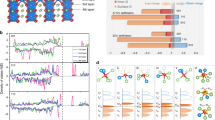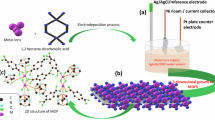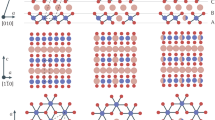Abstract
The short charging times and high power capabilities associated with capacitive energy storage make this approach an attractive alternative to batteries. One limitation of electrochemical capacitors is their low energy density and for this reason, there is widespread interest in pseudocapacitive materials that use Faradaic reactions to store charge. One candidate pseudocapacitive material is orthorhombic MoO3 (α-MoO3), a layered compound with a high theoretical capacity for lithium (279 mA h g−1 or 1,005 C g−1). Here, we report on the properties of reduced α-MoO3−x(R-MoO3−x) and compare it with fully oxidized α-MoO3 (F-MoO3). The introduction of oxygen vacancies leads to a larger interlayer spacing that promotes faster charge storage kinetics and enables the α-MoO3 structure to be retained during the insertion and removal of Li ions. The higher specific capacity of the R-MoO3−x is attributed to the reversible formation of a significant amount of Mo4+ following lithiation. This study underscores the potential importance of incorporating oxygen vacancies into transition metal oxides as a strategy for increasing the charge storage kinetics of redox-active materials.
This is a preview of subscription content, access via your institution
Access options
Subscribe to this journal
Receive 12 print issues and online access
$259.00 per year
only $21.58 per issue
Buy this article
- Purchase on SpringerLink
- Instant access to full article PDF
Prices may be subject to local taxes which are calculated during checkout





Similar content being viewed by others
References
Stevenson, K. J., Ozolins, V. & Dunn, B. Electrochemical energy storage. Acc. Chem. Res. 46, 1051–1052 (2013).
Miller, J. R. & Simon, P. Electrochemical capacitors for energy management. Science 321, 651–652 (2008).
Simon, P., Gogotsi, Y. & Dunn, B. Where do batteries end and supercapacitors begin? Science 343, 1210–1211 (2014).
Lee, H. Y. & Goodenough, J. B. Ideal supercapacitor behavior of amorphous V2O5nH2O in potassium chloride (KCl) aqueous solution. J. Solid State Chem. 148, 81–84 (1999).
Toupin, M., Brousse, T. & Bélanger, D. Charge storage mechanism of MnO2 electrode used in aqueous electrochemical capacitor. Chem. Mater. 16, 3184–3190 (2004).
Zheng, J. P., Cygan, P. J. & Jow, T. R. Hydrous ruthenium oxide as an electrode material for electrochemical capacitors. J. Electrochem. Soc. 142, 2699–2703 (1995).
Brousse, T. et al. Long-term cycling behavior of asymmetric activated carbon/MnO2 aqueous electrochemical supercapacitor. J. Power Sources 173, 633–641 (2007).
Brezesinski, K. et al. Pseudocapacitive contributions to charge storage in highly ordered mesoporous group V transition metal oxides with iso-oriented layered nanocrystalline domains. J. Am. Chem. Soc. 132, 6982–6990 (2010).
Li, W., Cheng, F., Tao, Z. & Chen, J. Vapor-transportation preparation and reversible lithium intercalation/deintercalation of α-MoO3 microrods. J. Phys. Chem. B 110, 119–124 (2006).
Tsumura, T. & Inagaki, M. Lithium insertion/extraction reaction on crystalline MoO3 . Solid State Ion. 104, 183–189 (1997).
Zhou, L. et al. α-MoO3 nanobelts: a high performance cathode material for lithium ion batteries. J. Phys. Chem. C 114, 21868–21872 (2010).
Lee, S. H. et al. Reversible lithium-ion insertion in molybdenum oxide nanoparticles. Adv. Mater. 20, 3627–3632 (2008).
Chernova, N. A., Roppolo, M., Dillon, A. C. & Whittingham, M. S. Layered vanadium and molybdenum oxides: batteries and electrochromics. J. Mater. Chem. 19, 2526–2552 (2009).
Mendoza-Sánchez, B. & Grant, P. S. Charge storage properties of a α-MoO3/carboxyl-functionalized single-walled carbon nanotube composite electrode in a Li ion electrolyte. Electrochim. Acta 98, 294–302 (2013).
Iriyama, Y., Abe, T., Inaba, M. & Ogumi, Z. Transmission electron microscopy (TEM) analysis of two-phase reaction in electrochemical lithium insertion within α-MoO3 . Solid State Ion. 135, 95–100 (2000).
Chen, J. S., Cheah, Y. L., Madhavi, S. & Lou, X. W. Fast synthesis of α-MoO3 nanorods with controlled aspect ratios and their enhanced lithium storage capabilities. J. Phys. Chem. C 114, 8675–8678 (2010).
Reddy, C. V. S., Walker, E. H., Wen, C. & Mho, S. I. Hydrothermal synthesis of MoO3 nanobelts utilizing poly(ethylene glycol). J. Power Sources 183, 330–333 (2008).
Hassan, M. F., Guo, Z. P., Chen, Z. & Liu, H. K. Carbon-coated MoO3 nanobelts as anode materials for lithium-ion batteries. J. Power Sources 195, 2372–2376 (2010).
Riley, L. A., Lee, S. H., Gedvilias, L. & Dillon, A. C. Optimization of MoO3 nanoparticles as negative-electrode material in high-energy lithium ion batteries. J. Power Sources 195, 588–592 (2010).
Kang, J. H., Paek, S. M. & Choy, J. H. In situ X-ray absorption spectroscopic study for α-MoO3 electrode upon discharge/charge reaction in lithium secondary batteries. Bull. Korean Chem. Soc. 31, 3675–3678 (2010).
Mai, L. et al. Lithiated MoO3 nanobelts with greatly improved performance for lithium batteries. Adv. Mater. 19, 3712–3716 (2007).
Wang, X.-J., Nesper, R., Villevieille, C. & Novák, P. Ammonolyzed MoO3 nanobelts as novel cathode material of rechargeable Li-ion batteries. Adv. Energy Mater. 3, 606–614 (2013).
Mendoza-Sánchez, B. et al. An investigation of nanostructured thin film α-MoO3 based supercapacitor electrodes in an aqueous electrolyte. Electrochim. Acta 91, 253–260 (2013).
Brezesinski, T., Wang, J., Tolbert, S. H. & Dunn, B. Ordered mesoporous α-MoO3 with iso-oriented nanocrystalline walls for thin-film pseudocapacitors. Nat. Mater. 9, 146–151 (2010).
Balendhran, S. et al. Enhanced charge carrier mobility in two-dimensional high dielectric molybdenum oxide. Adv. Mater. 25, 109–114 (2013).
Hu, X. K. et al. Comparative study on MoO3 and HxMoO3 nanobelts: structure and electric transport. Chem. Mater. 20, 1527–1533 (2008).
Dieterle, M., Weinberg, G. & Mestl, G. Raman spectroscopy of molybdenum oxides: part I. Structural characterization of oxygen defects in MoO3–x by DR UV/VIS, Raman spectroscopy and X-ray diffraction. Phys. Chem. Chem. Phys. 4, 812–821 (2002).
Wang, G., Ling, Y. & Li, Y. Oxygen-deficient metal oxide nanostructures for photoelectrochemical water oxidation and other applications. Nanoscale 4, 6682–6691 (2012).
Lu, X. et al. Hydrogenated TiO2 nanotube arrays for supercapacitors. Nano Lett. 12, 1690–1696 (2012).
Shin, J.-Y., Joo, J. H., Samuelis, D. & Maier, J. Oxygen-deficient TiO2−δ nanoparticles via hydrogen reduction for high rate capability lithium batteries. Chem. Mater. 24, 543–551 (2012).
Xu, L. et al. 3D flowerlike α-nickel hydroxide with enhanced electrochemical activity synthesized by microwave-assisted hydrothermal method. Chem. Mater. 20, 308–316 (2008).
Murugan, A. V., Muraliganth, T. & Manthiram, A. Comparison of microwave assisted solvothermal and hydrothermal syntheses of LiFePO4/C nanocomposite cathodes for lithium ion batteries. J. Phys. Chem. C 112, 14665–14671 (2008).
Cook, J. B., Kim, C., Xu, L. & Cabana, J. The effect of Al substitution on the chemical and electrochemical phase stability of orthorhombic LiMnO2 . J. Electrochem. Soc. 160, A46–A52 (2013).
Lindström, H. et al. Li+ ion insertion in TiO2 (anatase). 2. Voltammetry on nanoporous films. J. Phys. Chem. B 101, 7717–7722 (1997).
Wang, J., Polleux, J., Lim, J. & Dunn, B. Pseudocapacitive contributions to electrochemical energy storage in TiO2 (anatase) nanoparticles. J. Phys. Chem. C 111, 14925–14931 (2007).
Augustyn, V., Simon, P. & Dunn, B. Pseudocapacitive oxide materials for high-rate electrochemical energy storage. Energy Environ. Sci. 7, 1597–1614 (2014).
Bard, A. J. & Faulkner, L. R. Electrochemical Methods: Fundamentals and Applications 2nd edn (Wiley, 2001).
Hashem, A. M. et al. Two-phase reaction mechanism during chemical lithium insertion into α-MoO3 . Ionics 13, 3–8 (2007).
Kim, H.-S., Cook, J. B., Tolbert, S. H. & Dunn, B. The development of pseudocapacitive properties in nanosized-MoO2 . J. Electrochem. Soc. 162, A5083–A5090 (2015).
Augustyn, V. et al. High-rate electrochemical energy storage through Li+ intercalation pseudocapacitance. Nat. Mater. 12, 518–522 (2013).
Muller, G. A. et al. High performance pseudocapacitor based on 2D layered metal chalcogenide nanocrystals. Nano Lett. 15, 1911–1917 (2015).
Perdew, J. P., Burke, K. & Ernzerhof, M. Generalized gradient approximation made simple. Phys. Rev. Lett. 77, 3865–3868 (1996).
Dal Corso, A. Projector augmented wave method with spin–orbit coupling: applications to simple solids and zincblende-type semiconductors. Phys. Rev. B 86, 08135 (2012).
Kresse, G. & Furthmuller, J. Efficiency of ab-initio total energy calculations for metals and semiconductors using a plane-wave basis set. Comput. Mater. Sci. 6, 15–50 (1996).
Dudarev, S. L. et al. Electron-energy-loss spectra and the structural stability of nickel oxide: An LSDA + U study. Phys. Rev. B 57, 1505–1509 (1998).
Klimes, J., Bowler, D. R. & Michaelides, A. Van der Waals density functionals applied to solids. Phys. Rev. B 83, 195131 (2011).
Ding, H. et al. Computational investigation of electron small polarons in α-MoO3 . J. Phys. Chem. C 118, 15565–15572 (2014).
Ong, S. P., Chevrier, V. L. & Ceder, G. Comparison of small polaron migration and phase separation in olivine LiMnPO4 and LiFePO4 using hybrid density functional theory. Phys. Rev. B 83, 075112 (2011).
Cheng, J., Sulpizi, M., VandeVondele, J. & Sprik, M. Hole localization and thermochemistry of oxidative dehydrogenation of aqueous rutile TiO2(110). ChemCatChem 4, 636–640 (2012).
Monkhorst, H. J. & Pack, J. D. Special points for Brillouin-zone integrations. Phys. Rev. B 13, 5188–5192 (1976).
Ding, H., Ray, K. G., Ozolins, V. & Asta, M. Structural and vibrational properties of α-MoO3 from van der Waals corrected density functional theory calculations. Phys. Rev. B 85, 012104 (2012).
Staskiewicz, B. A., Tucker, J. R. & Snyder, P. E. The heat of formation of molybdenum dioxide and molybdenum trioxide. J. Am. Chem. Soc. 77, 2987–2989 (1955).
Aydinol, M. K., Kohan, A. F. & Ceder, G. Ab initio calculation of the intercalation voltage of lithium transition metal oxide electrodes for rechargeable batteries. J. Power Sources 68, 664–668 (1997).
Acknowledgements
This work was supported as part of the Center for Molecularly Engineered Energy Materials, an Energy Frontier Research Center funded by the US Department of Energy, Office of Science, Office of Basic Energy Sciences, under award DE-SC001342 and through individual DOE grant DE-SC0014213 (S.H.T.). The XPS instrument used in this work was obtained with support from the NSF, award number 0840531. This research used resources of the National Energy Research Scientific Computing Center, a DOE Office of Science User Facility supported by the Office of Science of the US Department of Energy under Contract No. DE-AC02-05CH11231. H.L. and V.O. acknowledge financial support from the U.S. DOE under grant DE-FG02-07ER46433. Additional support was provided by the Office of Naval Research. We thank E. D. Gaspera for his experimental insights.
Author information
Authors and Affiliations
Contributions
H.-S.K., J.S.K. and J.B.C.: experimental work and data analysis. H.L.: computational study. S.H.T., V.O. and B.D.: project planning and data analysis.
Corresponding authors
Ethics declarations
Competing interests
The authors declare no competing financial interests.
Supplementary information
Supplementary Information
Supplementary Information (PDF 1529 kb)
Rights and permissions
About this article
Cite this article
Kim, HS., Cook, J., Lin, H. et al. Oxygen vacancies enhance pseudocapacitive charge storage properties of MoO3−x. Nature Mater 16, 454–460 (2017). https://doi.org/10.1038/nmat4810
Received:
Accepted:
Published:
Issue Date:
DOI: https://doi.org/10.1038/nmat4810
This article is cited by
-
A facile approach for generating ordered oxygen vacancies in metal oxides
Nature Materials (2025)
-
Efficient syngas conversion via catalytic shunt
Nature Sustainability (2025)
-
Unveiling ECRAM switching mechanisms using variable temperature Hall measurements for accelerated AI computation
Nature Communications (2025)
-
Green Chemistry Innovation in Flexible Electrodes for Wearable Technology
Journal of Electronic Materials (2025)
-
High-Performance Stainless-Steel-Fiber-Reinforced Thick Ultra-flexible Electrode Applicable to 3D Free-Form Batteries
Advanced Fiber Materials (2025)



